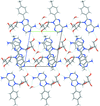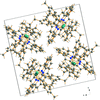issue contents
January 2018 issue

Cover illustration: In recent years, factor Xa inhibitors, a new type of anticoagulant drug, have received considerable attention. Rivaroxaban, illustrated here, is a representative drug of factor Xa inhibitors. It inhibits the formation of thrombin by inhibiting factor Xa activity, which in turn impedes the formation of fibrin and ultimately inhibits thrombus formation and enlargement. It crystallized with two independent molecules in the asymmetric unit, which have different conformations, with the N-methylformamide moieties having C-C-N-C torsion angles of -171.1 (7) and -106.8 (9)°. See: Shen, Tang & Hu [Acta Cryst. (2018). E74, 51-54].
research communications








































 journal menu
journal menu





































